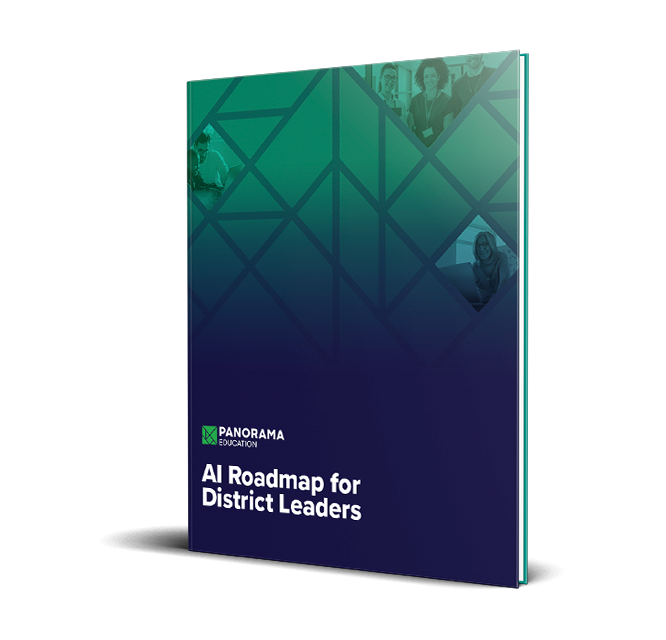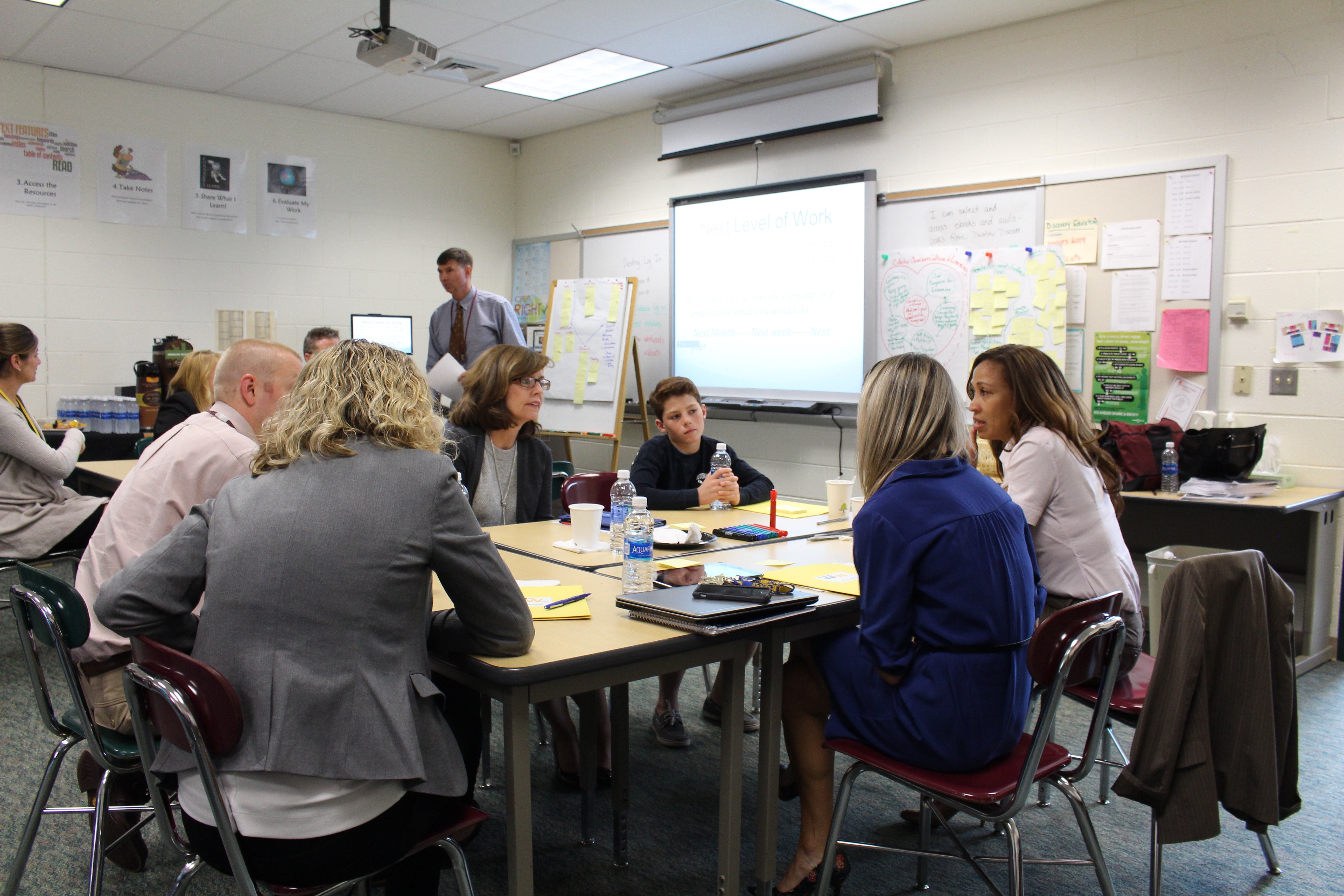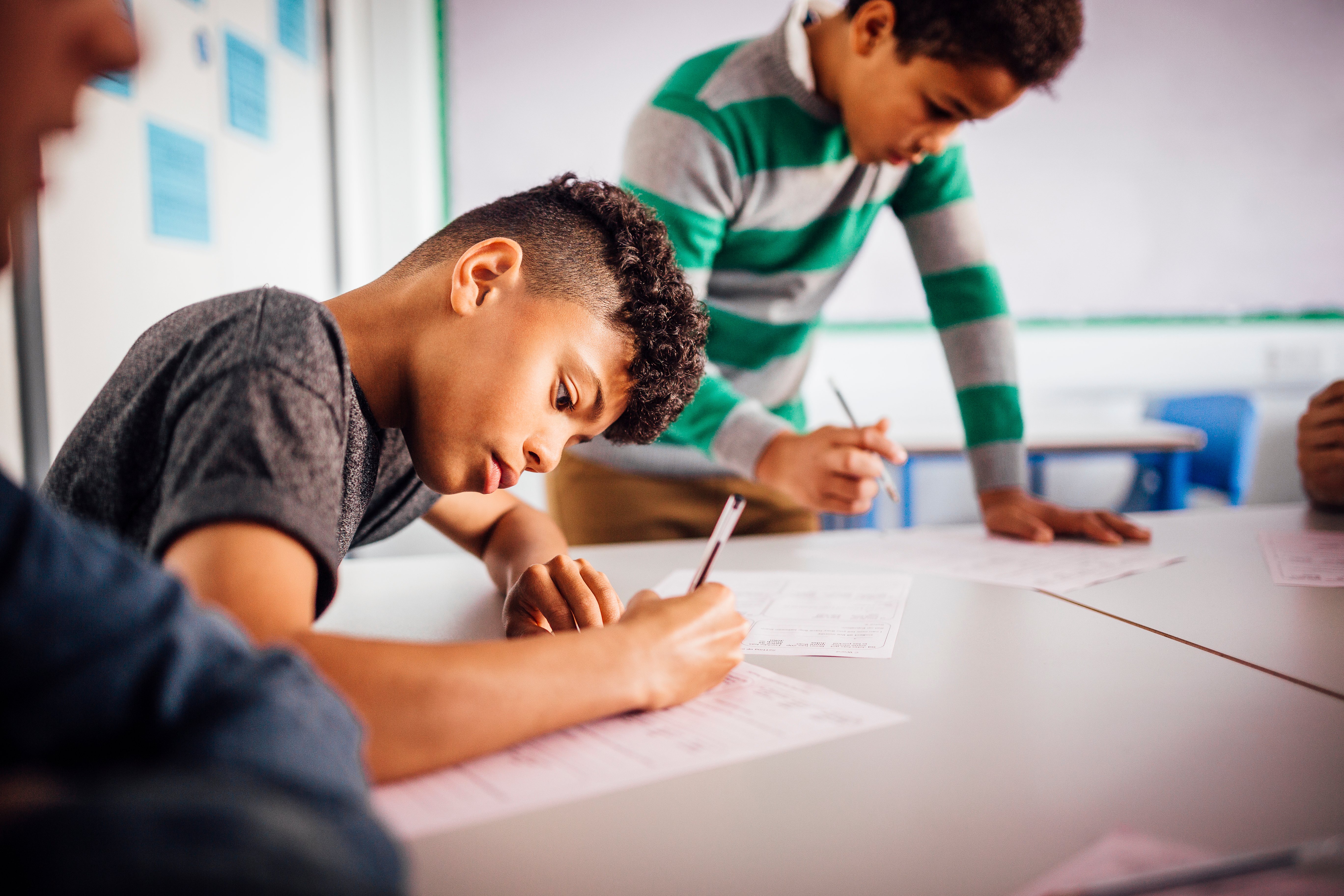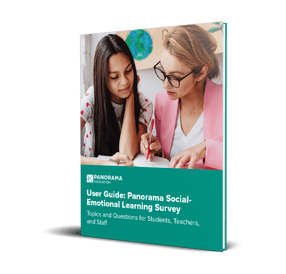When implementing social-emotional learning (SEL), it can be helpful to narrow your focus to a few SEL competencies that are most relevant for the students and educators in your school community.
That's why many district and school leaders use the framework from CASEL (the Collaborative for Academic, Social, and Emotional Learning). CASEL outlines five core social-emotional learning competencies that can be taught in many ways in any type of school or district community.
In this guide, you'll learn about the five core SEL competencies—complete with definitions and examples of what these competencies may look like and sound like in practice. For each core competency, we also share examples of low-lift SEL strategies, activities, and teaching practices that you can use right away in your school community to promote student SEL and adult SEL.
Keep reading or use the shortcuts below to access different sections of this guide.
Table of Contents
I. What Is Social-Emotional Learning?
II. The 5 Core SEL Competencies
III. Assessing the Core SEL Competencies
IV. Data Integration for Comprehensive Student Support
|
Key Takeaways:
|
Download Panorama's SEL Survey
What Is Social-Emotional Learning?
|
Social-emotional learning (SEL) is an integral part of education and human development. SEL is the process through which all young people and adults acquire and apply the knowledge, skills, and attitudes to develop healthy identities, manage emotions and achieve personal and collective goals, feel and show empathy for others, establish and maintain supportive relationships, and make responsible and caring decisions. |
In other words, social and emotional learning describes the skills that educators do not explicitly teach. It can be apparent when social-emotional skills are present or absent in students. A 2017 meta-analysis from CASEL involving students from kindergarten to high school showed that students exposed to SEL programs performed better academically (13 percentile points higher) than their non-SEL peers.
What Are Social-Emotional Competencies?
Social-emotional learning competencies are the specific skills, habits, and mindsets that fall under the umbrella of social-emotional learning. These skills are varied, and school communities may prioritize different SEL competencies based on identifiable student needs or the district's portrait of a graduate. However, many school districts focus on CASEL's five core SEL competencies as a starting point.
The Five Core SEL Competencies
|
Now that we've outlined the five core competencies, let's take a look at each in depth. We'll also look at specific activities for promoting the different components of socio-emotional development.
Core Competency #1: Self-Awareness
Self-awareness is the ability to understand one’s own emotions, thoughts, and values and how they influence behavior across contexts. This includes capacities to recognize one’s strengths and limitations with a well-grounded sense of confidence and purpose.
Self-Awareness May Look Like:
- Identifying emotions
- Having an accurate self-perception
- Recognizing strengths
- Self-confidence
- Self-efficacy
Self-Awareness May Sound Like:
- How am I feeling and why?
- When am I at my best?
- When do I feel angry?
- What kind of person do I want to be today?
- What stresses me out?
- Where do I fit into my family/community?
Self-Awareness Strategy: The Feelings Wheel
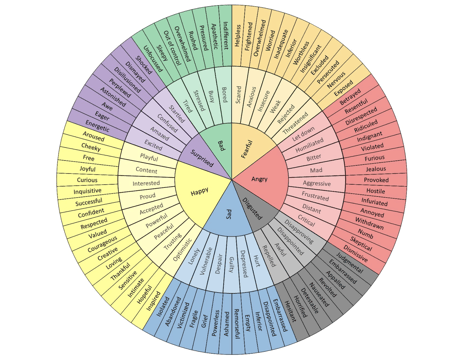 The Feelings Wheel (see the image to the right) helps students acknowledge their emotions and feelings so that they can move into action and respond constructively to those feelings.
The Feelings Wheel (see the image to the right) helps students acknowledge their emotions and feelings so that they can move into action and respond constructively to those feelings.
How it works: Let's say you are feeling "fearful." Locate that feeling on the wheel, then move one ring out and identify another emotion. Keep moving to the last ring on the wheel. By accurately identifying your emotions, you can do something about it and handle these emotions in a productive way.
|
For You: Quiet time; meals, mornings, or before bed For Students: Dedicated time during the day; daily/weekly check-ins; buddy system |
Self-Awareness Strategy: Positive Pivot
The Positive Pivot Scale is a high school strategy from Move This World that helps students consider a range of ways to respond to a situation. The scale runs from negative 5 to positive 5.
Explore more high school activities for social-emotional learning aligned to the CASEL competencies.
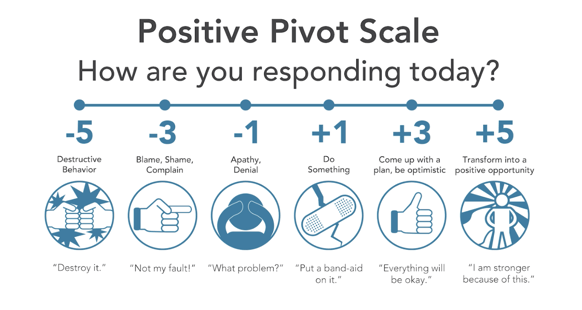
How it works: Consider a challenge you are facing today. Identify where you are currently responding on the Positive Pivot Scale. Then, ask yourself: What would I need to do to move to a higher number on the Positive Pivot Scale?
|
For You: Quiet time; meals, mornings, or before bed For Students: Dedicated time during the day; daily/weekly check-ins; buddy system |
Core Competency #2: Self-Management
Self-management is the ability to manage one’s emotions, thoughts, and behaviors effectively in different situations and to achieve goals and aspirations. This includes the capacities to delay gratification, manage stress, and feel motivation and agency to accomplish personal and collective goals.
Self-Management May Look Like:
- Impulse control
- Stress management
- Self-discipline
- Self-motivation
- Goal-setting
- Organizational skills
Self-Management May Sound Like:
- I need a break right now
- May I please have space? I am not ready to share.
- I think I need help with _______.
- I don't understand yet, but I will ________ to reach my goal.
Self-Management Strategy: Positive Self-Talk
Self-talk is "the act of practice of talking to oneself, either aloud or silently and mentally." Generally, negative self-talk makes us feel worse, but positive self-talk can make us feel better because it triggers problem-solving and helps remind ourselves that making mistakes is part of life.
Two examples of shifting from negative to positive self-talk include:
- You are overwhelmed by the amount of tech it’s going to take to teach your class.
"This is never going to work! I'm not tech-savvy" to "I can ask someone to help me, and it will become easier." - You have an important question for the teacher, but the teacher tells you that he/she doesn’t have time to answer it. "I can't figure this out by myself!" to "It will take time, but I can learn this."
|
For You: Pay attention to your thoughts and words, and pivot as needed For Students: Explicitly teach positive self-talk through mini-lessons and hold students accountable |
Self-Management Strategy: WOOP Goal-Setting
The WOOP activity from Character Lab helps students find their wishes and develop an action plan to fulfill those wishes. WOOP is named for each step in the process: identifying your Wish, imagining the Outcome, anticipating the Obstacle, and developing a specific Plan.
W: What is an important wish that you want to accomplish? Your wish should be challenging but feasible.
O: What will be the best result from accomplishing your wish? How will you feel? Pause and really imagine the outcome.
O: What is the main obstacle inside you that might prevent you from accomplishing your wish? Pause and really imagine the obstacle.
P: What’s an effective action to tackle the obstacle? Make a when-then plan.
|
For You: Make time for goal-setting. For Students: Google forms, Flipgrid (video recording), and monitor progress |
Core Competency #3: Social Awareness
Social awareness is the ability to understand the perspectives of and empathize with others, including those from diverse backgrounds, cultures, and contexts. This includes the capacities to feel compassion for others, understand broader historical and social norms for behavior in different settings, and recognize family, school, and community resources and supports.
Social Awareness May Look Like:
- Perspective taking
- Empathy
- Appreciating different perspectives
- Respect for others
Social Awareness May Sound Like:
- I wonder how that made _______ feel?
- How would I feel if I were in that situation?
- What is ________ thinking?
- They seem sad right now. Maybe I should _______.
- Thanks for sharing! My family does it this way.
Social Awareness Strategy: The Listening Circle
The Listening Circle teaches empathy, provides an opportunity to hear (or read) different perspectives, and builds community. In a listening circle, students have a safe space to share their voices by responding to prompts. Example prompts include: "Who do you look up to the most, and why?" and "What advice would you give yourself today, and why?"
|
For You: Connect with friends and family via social media, phone, Zoom For Students: Make time for it in the classroom or virtually (Zoom breakout rooms, Flipgrid, Padlet) |
Core Competency #4: Relationship Skills
Relationship skills are the ability to establish and maintain healthy and supportive relationships and to effectively navigate settings with diverse individuals and groups. This includes the capacities to communicate clearly, listen actively, cooperate, work collaboratively to problem solve and negotiate conflict constructively, navigate settings with differing social and cultural demands and opportunities, provide leadership, and seek or offer help when needed.
Relationship Skills May Look Like:
- Communication
- Social engagement
- Relationship building
- Teamwork
Relationship Skills May Sound Like:
- When you ______ it made me feel _______.
- Can you explain what you mean by that?
- I disagree with you because _________.
- What did you mean by _________?
Relationship Skills Strategy: Count Me Down
Count Me Down is a strategy from Move This World that helps students identify ways they are similar and different from others. The goals are to develop a stronger understanding of peers and to demonstrate respect for differences and exhibit empathy. An example prompt for Count Me Down is as follows:
- 3 unique things about your family
- 2 challenges you're currently facing
- 1 goal or dream you have
|
For You: Use the prompt to journal about things in your life For Students: Make time for it in the classroom or virtually (Zoom breakout rooms, Flipgrid, Padlet) |
Relationship Skills Strategy: Rose, Bud, Thorn
Rose, Bud, Thorn is a strategy that helps students identify positive moments and areas where they need support. During this activity, students share a:
- Rose: Something positive that happened this past week
- Bud: Something you are looking forward to next week
- Thorn: Something you need help with in the next week
To foster grit and growth mindset, students may also consider ways to turn thorns into roses.
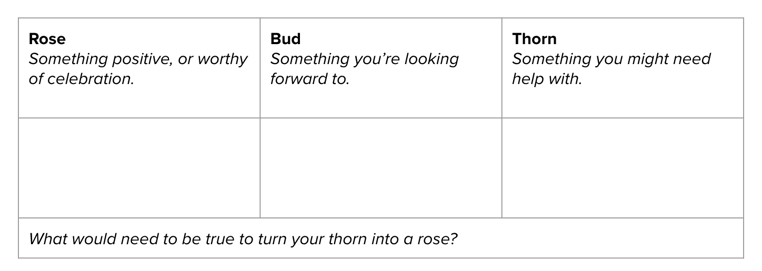
|
For You: Reflect on what went well and what you need help with; communicate when you need help turning thorns into roses For Students: Make time for it in the classroom or virtually (Zoom breakout rooms, Flipgrid, Padlet) |
Core Competency #5: Responsible Decision-Making
Responsible decision-making is the ability to make caring and constructive choices about personal behavior and social interactions across diverse situations. This includes the capacities to consider ethical standards and safety concerns, and to evaluate the benefits and consequences of various actions for personal, social, and collective well-being.
Responsible Decision-Making May Look Like:
- Identifying problems
- Analyzing situations
- Solving problems
- Evaluating
- Reflecting
- Ethical responsibility
Responsible Decision-Making May Sound Like:
- How will this impact others?
- Is it worth it?
- Why do I want to make this choice?
- Was this a strong choice?
- Will this help me?
Responsible Decision-Making Strategy: The POOCH Protocol
POOCH is a process for problem-solving that can help students thoughtfully generate solutions to problems by thinking through possible options and outcomes. The steps are as follows:
- Identify the problem.
- Explore different options to solve the problem.
- Discuss an outcome for each option.
- Choose an option.
- Reflect on how things went.
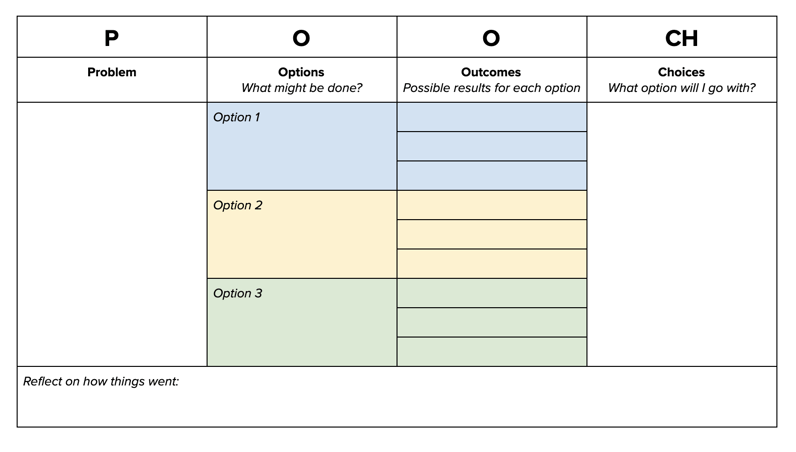 Access the POOCH template as a Google Doc.
Access the POOCH template as a Google Doc.
|
For You: Use it when faced with difficult decisions For Students: Use as a tool to collectively solve problems |
Assessing the Core SEL Competencies
Once your school or district has identified specific SEL competencies to focus on, the next step is to gather baseline data on how students are developing those skills, mindsets, and competencies. SEL data can help educators identify individual students' strengths and areas for growth related to specific competencies. At the school and district level, the data can help guide school climate improvement plans and tier one SEL instruction.
The Panorama Social-Emotional Learning Survey (open-source and available for download), aligned to the CASEL framework, is a great tool to get started measuring SEL. The survey, developed at the Harvard Graduate School of Education, contains more than 22 research-backed topics to help school districts gather valid and reliable social-emotional learning data from students.
Data Integration for Comprehensive Student Support
School districts often struggle with fragmented and complex systems that make it difficult to unify student data and take action to support students. Panorama offers a user-friendly platform called Student Success that simplifies the integration of social-emotional learning (SEL) data with academic, behavioral, and attendance data.
Student Success is a one-stop shop that unifies data across academics, attendance, and behavior, offering a holistic view of your district, schools, and students. Panorama is the only company to offer both social-emotional learning surveys and MTSS tools, enabling educators to prioritize students’ needs, experiences, and feedback when developing intervention plans.
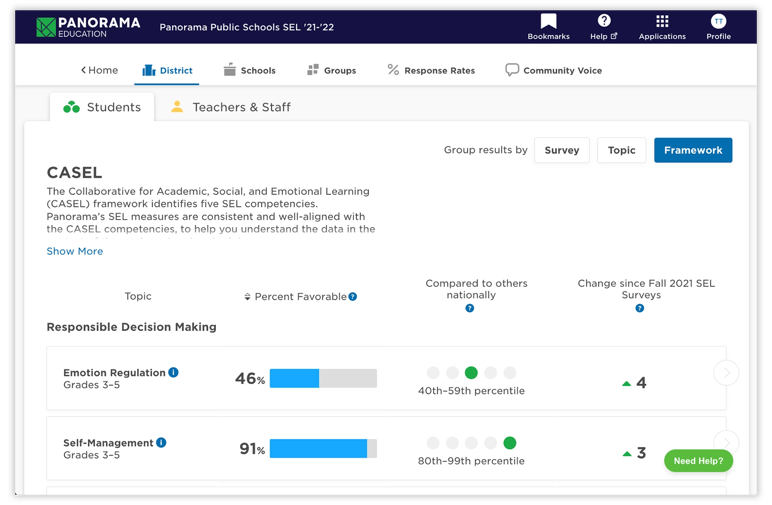
Example of Panorama's SEL dashboards (mock data pictured)
|
Frequently Asked Questions: 1. Why is social-emotional learning (SEL) becoming increasingly important in educational settings? Social-emotional learning is gaining importance in education due to its proven ability to enhance students' overall well-being, academic performance, and long-term life outcomes. It equips students with crucial skills such as self-awareness, empathy, and responsible decision-making, which are essential for navigating diverse social and academic environments. 2. How can educators effectively engage students in social-emotional learning (SEL) activities? Educators can engage students in SEL activities by making them interactive, relevant, and experiential. Incorporating role-playing, group discussions, real-life scenarios, and reflection exercises can foster meaningful connections and active participation among students, leading to deeper understanding and internalization of social-emotional learning concepts. 3. What are some common challenges schools face when implementing social-emotional learning (SEL) programs? Common challenges include limited resources and funding, resistance to change among staff or students, lack of time and training for educators, and the need for ongoing evaluation and adaptation of SEL initiatives to meet the diverse needs of students and the school community. 4. How can parents support social-emotional learning (SEL) at home? Parents can support SEL at home by modeling positive behaviors and communication, fostering open dialogue about emotions and relationships, providing opportunities for their children to practice empathy and problem-solving, and collaborating with educators to reinforce social-emotional learning concepts learned in school. 5. Are there specific strategies for integrating social-emotional learning (SEL) into remote or virtual learning environments? Yes, educators can integrate SEL into remote learning by incorporating virtual mindfulness exercises, facilitating online discussions about emotions and coping strategies, using digital storytelling to promote empathy and perspective-taking, and providing virtual peer support networks for students to connect and share experiences. |
Access Panorama's Social-Emotional Learning Survey—with 30+ Survey Topics for Students and Adults
